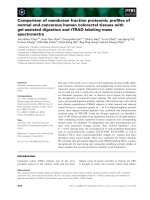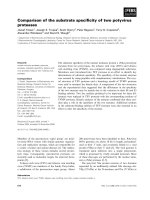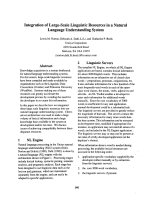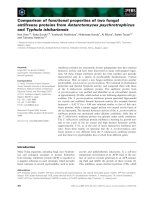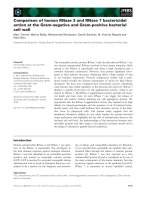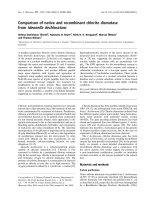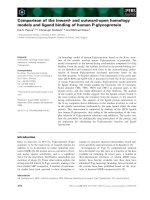Báo cáo khoa học: "Comparison of different pain scoring systems in critically ill patients in a general ICU" pdf
Bạn đang xem bản rút gọn của tài liệu. Xem và tải ngay bản đầy đủ của tài liệu tại đây (348.53 KB, 8 trang )
Open Access
Available online />Page 1 of 8
(page number not for citation purposes)
Vol 12 No 1
Research
Comparison of different pain scoring systems in critically ill
patients in a general ICU
Sabine JGM Ahlers
1,2,3
, Laura van Gulik
1
, Aletta M van der Veen
1
, Hendricus PA van Dongen
1
,
Peter Bruins
1
, Svetlana V Belitser
4
, Anthonius de Boer
4
, Dick Tibboel
3
and Catherijne AJ Knibbe
2,3
1
Department of Anaesthesiology and Intensive Care, St. Antonius Hospital, Koekoekslaan 1, Nieuwegein, 3440 EM, The Netherlands
2
Department of Clinical Pharmacy, St. Antonius Hospital, Koekoekslaan 1, Nieuwegein, 3440 EM, The Netherlands
3
Department of Pediatric Surgery, Erasmus Medical Centre, Sophia Children's Hospital, Dr. Molewaterplein 60, Rotterdam, 3015 GJ, The
Netherlands
4
Department of Pharmacoepidemiology and Pharmacotherapy, Faculty of Pharmaceutical Sciences, University of Utrecht, Sorbonnelaan 16, Utrecht,
3584 CA, The Netherlands
Corresponding author: Sabine JGM Ahlers,
Received: 19 Nov 2007 Revisions requested: 11 Dec 2007 Revisions received: 11 Jan 2008 Accepted: 16 Feb 2008 Published: 16 Feb 2008
Critical Care 2008, 12:R15 (doi:10.1186/cc6789)
This article is online at: />© 2008 Ahlers et al.; licensee BioMed Central Ltd.
This is an open access article distributed under the terms of the Creative Commons Attribution License ( />),
which permits unrestricted use, distribution, and reproduction in any medium, provided the original work is properly cited.
Abstract
Background Pain in critically ill patients in the intensive care unit
(ICU) is common. However, pain assessment in critically ill
patients often is complicated because these patients are unable
to communicate effectively. Therefore, we designed a study (a)
to determine the inter-rater reliability of the Numerical Rating
Scale (NRS) and the Behavioral Pain Scale (BPS), (b) to
compare pain scores of different observers and the patient, and
(c) to compare NRS, BPS, and the Visual Analog Scale (VAS)
for measuring pain in patients in the ICU.
Methods We performed a prospective observational study in
113 non-paralyzed critically ill patients. The attending nurses,
two researchers, and the patient (when possible) obtained 371
independent observation series of NRS, BPS, and VAS. Data
analyses were performed on the sample size of patients (n =
113).
Results Inter-rater reliability of the NRS and BPS proved to be
adequate (kappa = 0.71 and 0.67, respectively). The level of
agreement within one scale point between NRS rated by the
patient and NRS scored by attending nurses was 73%.
However, high patient scores (NRS ≥4) were underestimated by
nurses (patients 33% versus nurses 18%). In responsive
patients, a high correlation between NRS and VAS was found
(r
s
= 0.84, P < 0.001). In ventilated patients, a moderate positive
correlation was found between the NRS and the BPS (r
s
= 0.55,
P < 0.001). However, whereas 6% of the observations were
NRS of greater than or equal to 4, BPS scores were all very low
(median 3.0, range 3.0 to 5.0).
Conclusion The different scales show a high reliability, but
observer-based evaluation often underestimates the pain,
particularly in the case of high NRS values (≥4) rated by the
patient. Therefore, whenever this is possible, ICU patients
should rate their pain. In unresponsive patients, primarily the
attending nurse involved in daily care should score the patient's
pain. In ventilated patients, the BPS should be used only in
conjunction with the NRS nurse to measure pain levels in the
absence of painful stimuli.
Introduction
Pain is a frequently experienced problem in critically ill patients
in the intensive care unit (ICU) [1]. Pain may increase morbidity
and mortality and may decrease the comfort of patients and
health-related quality of life. The adequate use of analgesics
and sedatives therefore may decrease morbidity and mortality
[2]. Measurement of pain in ICU patients, however, may be
complicated by decreased consciousness, severity of illness,
mechanical ventilation, and the use of sedatives in these
patients, particularly when high doses of sedatives are admin-
istered [3,4]. Although self-report is still the 'gold standard' in
pain measurement according to the guidelines of the Interna-
tional Association for the Study of Pain [5], one segment of
ICU patients is unable to communicate effectively. In these
cases, the gold standard (that is, the pain intensity reported by
the patient) is not possible or is potentially unreliable. This is
BPS = Behavioral Pain Scale; ICU = intensive care unit; NRS = Numerical Rating Scale; r
s
= Spearman non-parametric rank correlation coefficient;
RS = Ramsay Scale; VAS = Visual Analog Scale.
Critical Care Vol 12 No 1 Ahlers et al.
Page 2 of 8
(page number not for citation purposes)
also a common problem in, for example, neonates and chil-
dren, who are not able to report pain in a reliable manner [6].
Therefore, pain assessment in the ICU remains a challenge for
clinicians and researchers. There is no specific neurobiologi-
cal parameter for the evaluation of pain, nor does an objective
quantification of pain intensity or relief exist [7]. Various pain
scales are available, but it remains unclear whether they can
be applied reliably in the diverse patient population of the ICU,
where patients not only may be mechanically ventilated but
also are subject to repeated painful procedures. Therefore, it
is of interest to define which score should be used for which
patient (for example, ventilated, responsive, or unresponsive)
and by which health care worker, in case the patient cannot
communicate. These results can be used to implement a sys-
tematic evaluation of pain in all ICU patients. While, to date,
the use of scoring systems for pain severity and sedation
depth and the implementation of protocols increase with a
more patient-oriented regime for analgesia and sedation, a
trend is observed away from a hypnosis-based approach and
toward an analgesia-based approach. Although these
changes may improve pain and sedation practice, further
efforts are needed for widespread implementation of pain
scoring systems and analgesia protocols [8,9]. Of the availa-
ble pain scales, the Numerical Rating Scale (NRS) (1 to 10)
and the Visual Analog Scale (VAS) (1 to 100) have been vali-
dated for acute pain only and not in mechanically ventilated
patients in the ICU [10]. The Behavioral Pain Scale (BPS) was
developed specifically for measuring the severity of pain in
sedated, mechanically ventilated, unresponsive patients [11],
but this pain scale still is not generally accepted for routine
use. Another question in pain management in the ICU is which
health care worker (nurse, physician, and so on) should rate
pain in case the patient cannot communicate verbally. While
the attending nurse is involved in close daily care of the
patient, the physician seems to have a more distant relation to
the patient. Therefore, we designed a study (a) to determine
the inter-rater reliability of the NRS and BPS, (2) to compare
pain scores of different observers and the patient, and (c) to
compare NRS, VAS, and BPS for measuring pain in ventilated
and non-ventilated patients in the ICU.
Materials and methods
Design
A prospective observational study was performed in a 30-bed
surgical/medical ICU in a teaching hospital in Nieuwegein, The
Netherlands. The medical ethical committee of St. Antonius
Hospital approved the study protocol and waived the need for
informed consent because the observational study design and
pain measurement are part of the standard care.
Participants
All patients in the ICU who were at least 18 years old were
included between 27 June and 4 August 2005. Patients who
received neuromuscular blocking medications or muscle-para-
lyzing drugs continuously, who were unconscious after resus-
citation, who were quadriplegic, who suffered from a critical
illness (poly)neuropathy, or who had an epidural catheter were
excluded. Paralysis, whether caused by a pre-existing condi-
tion or by medication, makes the BPS unreliable.
Pain measurement instruments
To assess pain intensity, three pain scales (that is, BPS, NRS,
and VAS) were used. The BPS is used after an observation of
the patient for about 1 minute and was validated in critically ill,
sedated, and mechanically ventilated patients [10,11]. The
BPS is a pain scale for sedated and ventilated patients exclu-
sively and is based on the sum of three subscales: facial
expression, upper limb movements, and compliance with
mechanical ventilation (Table 1). Each subscale is scored from
1 (no response) to 4 (full response). Therefore, BPS scores
range from 3 (no pain) to 12 (maximal pain) [10,11]. The BPS
has a maximal acceptable pain score of 5 [12]. The NRS is
based on a scale from 0 to 10; 0 represents no pain and 10
represents the worst possible pain [13,14]. The NRS has a
maximal acceptable pain score of 3 [15]. The VAS is a 100-
mm ruler with a movable cursor. At the left side is written 'no
pain' and at the right side is written 'worst possible pain'. The
patient marks the intensity of pain [16,17]. The VAS has a max-
imal acceptable pain score of 30 mm.
Depth of sedation
The Ramsay Scale (RS) was used to assess the sedation level
[18]. The RS is a scale from 1 to 6, with higher levels indicating
increased degrees of sedation, and considers the following
levels: (1) patient anxious, agitated, and restless; (2) patient
cooperative, orientated, and tranquil; (3) patient drowsy or
asleep and responds easily to commands; (4) patient asleep
and gives a brisk response to a light glabellar tap; (5) patient
asleep and gives a sluggish response to a light glabellar tap;
and (6) patient asleep and gives no response to a light glabel-
lar tap [19].
Standard pain medication in the intensive care unit
All patients received pain medication according to the local
standard protocol, consisting of 1 gram of acetaminophen rec-
tally three times daily and 10 mg of morphine subcutaneously
four times daily or 30 to 50 mg of morphine per day using a
continuous intravenous infusion, if required.
Procedures
Before this study, levels of pain were not systematically scored
and recorded. During this study, assessments took place in all
patients in the ICU twice a day (at 8.30 a.m. and 3 p.m.) during
1 month. Assessments were initiated by two researchers who
were trainees in pharmacy and who had been working for 6
months under close supervision of two anesthesiologists of
the Department of Anaesthesiology/Intensive Care and one
ICU nurse. These researchers were not involved in the
patient's care but took notice of the clinical and medical situa-
Available online />Page 3 of 8
(page number not for citation purposes)
tion of the patient, similar to a physician on ward rounds. All
assessments were made during non-nociceptive procedures
in order to obtain basal pain scores. First, the researchers
observed every patient for about 1 minute. Assessments of the
researchers were made simultaneously but were independent
of each other. Then, the researchers scored the BPS, NRS,
and RS in order to prevent the outcome from being influenced
by the patient's or nurse's score. The BPS was scored only in
patients who were ventilated. Then, the attending nurse was
asked to score the pain of the patient with the NRS. If the
patient was responsive, the patient was asked to score the
pain using the NRS and VAS. Gender, height, weight, year of
birth, ICU indication, and relevant history were collected.
Patients were classified in one of the two ICU indications, 'car-
diothoracic surgery' or 'non-cardiothoracic surgery, with a
skewed distribution for 'cardiothoracic surgery'. In this study,
the 'NRS researcher' and 'BPS researcher' are defined by
NRS rating and BPS rating by the researcher. The 'RS
researcher' is defined by the RS rating by the researcher.
'NRS nurse' is defined by the NRS rating by the nurse. 'NRS
patient' and 'VAS patient' are defined by the NRS rating and
VAS ratings by the patient (Table 2).
Training pain measurement instruments
For adequate use of the BPS, NRS, VAS, and RS, the two
researchers attended a 4-hour training session (conducted by
a trained ICU nurse), during which the BPS and RS were
explained with examples of patients who were in the ICU at the
time of the training. When the inter-rater reliability was accept-
able according to a quadratic weighted Cohen's kappa of
greater than 0.6, the researchers were allowed to score
patients for the study [20].
Data analysis
Data were analyzed with the statistical software S-Plus
®
ver-
sion 6.2 (Insightful Corporation, Seattle, WA, USA). To correct
for the different numbers of measurements per patient, one
observation per patient was randomly selected. All statistical
analyses were performed using this independent sample,
while all measurements were plotted in the figures for better
illustration. Kappa coefficients with quadratic weights were
used to reflect agreement for ordinal scales (NRS, BPS, and
RS) between the independent researchers. Weighted kappa
penalizes disagreement in terms of their seriousness [20].
Theoretically, the value of kappa can range from 0 (disagree-
Table 1
The Behavioral Pain Scale [15]
Item Description Score
Facial expression Relaxed 1
Partially tightened 2
Fully tightened 3
Grimacing 4
Upper limbs No movement 1
Partially bent 2
Fully bent with finger flexion 3
Permanently retracted 4
Compliance with ventilation Tolerating movement 1
Coughing but tolerating ventilation for most of the time 2
Fighting ventilator 3
Unable to control ventilation 4
Table 2
Pain and sedation scales performed by researcher, nurse, and patient
Behavioral Pain Scale (if ventilated) Numerical Rating Scale Visual Analog Scale Ramsay Scale
Researcher × × ×
Nurse ×
Patient (whenever possible) × ×
Critical Care Vol 12 No 1 Ahlers et al.
Page 4 of 8
(page number not for citation purposes)
ment) to 1 (perfect agreement). A value larger than 0.6 was
regarded as satisfactory [21]. The 95% confidence intervals
for kappa coefficients were calculated. Spearman non-para-
metric rank correlation coefficients (r
s
) were used to measure
the degree of correlation for two ordinal variables. The null
hypothesis that the correlation coefficient is zero was tested.
A P value of less than 0.05 was considered statistically
significant.
Results
Patient characteristics and data
A total of 138 intensive care patients entered the study, with a
median of two observation series per patient (range 1 to 15).
In total, 25 patients were excluded (15 patients because of
incomplete collection of the data and 10 patients because of
exclusion criteria), resulting in a total of 113 included patients.
Table 3 shows the baseline characteristics of the patients. The
body mass index was recorded for 87 of 113 patients (77%).
In total, 371 observations were scored by the researchers and
322 observations were scored by the nurses. In a total of 75
patients (180 observations), the patient could report his or her
pain using the NRS. In 141 observations, the patient could
also report his or her pain using the VAS. Of the 57 ventilated
patients, 13 patients were communicative and could report
their pain.
Inter-rater reliability
Table 4 depicts the exact agreement, the agreement within
one scale point, and the quadratic weighted kappa for the
NRS, BPS, and RS in different groups of patients for the two
independent researchers. There was no difference between
the ICU indications 'cardiothoracic surgery' (n = 83) and 'non-
cardiothoracic surgery' (n = 30) in exact agreement (60% ver-
sus 57%) and agreement within one scale point (94% versus
93%).
NRS patient versus NRS nurse or NRS researcher
For the patients who were able to report their own pain levels
(n = 75), the level of agreement within one scale point
between NRS patient and NRS nurse was 73% compared
with 58% for the NRS researcher, corrected for multiple
observations per patient. Similar results were found for the
exact agreement (42% versus 19%, respectively). The corre-
lations between NRS of patient and nurses (Figure 1) and
between NRS of patient and researcher were moderate and
low, respectively (r
s
= 0.55, P < 0.001 versus r
s
= 0.38,
P = 0.009). Whereas 33% of the patients scored NRS values
of greater than or equal to 4, only 18% of the attending nurses
scored NRS values in that range. Apparently, particularly when
the patient rated his or her pain as unacceptable, nurses
tended to underestimate the pain level of the patient on the
NRS.
NRS patient and VAS patient
In responsive patients, there was a strong positive correlation
between the NRS patient and the VAS patient (r
s
= 0.84,
P < 0.001, n = 75; Figure 2). The correlation between NRS
patient and VAS patient was slightly lower in cardiothoracic
patients than in non-cardiothoracic patients (r
s
= 0.79,
P < 0.001, n = 25 patients versus r
s
= 0.95, P < 0.001,
n = 11 patients).
NRS nurse and BPS researcher
While a moderate positive correlation was found between the
NRS nurse and the BPS researcher in ventilated patients
(r
s
= 0.55, P < 0.001, n = 57 patients; Figure 3), Figure 3 also
shows that using the NRS, only 5% of the observations
(n = 151 observations of 57 patients) were NRS of 0 (no
pain), whereas on the BPS, 68% of the observations were
BPS of 3 (no pain). Besides, using the NRS, 6% of the obser-
vations were NRS of greater than or equal to 4, considered to
Table 3
Baseline patient characteristics
Number of patients 113
Age, years 66 ± 15
a
Male gender, number 78 (69%)
Body mass index, kg/m
2
26.6 ± 4.7
a
Diagnostic categories, number
Cardiothoracic surgery 83 (73%)
Non-cardiothoracic surgery 30 (27%)
Mechanical ventilation, number
None 56 (50%)
Pressure-support 36 (32%)
Volume-controlled 21 (19%)
Median Ramsay Scale score (range) 2.0 (1.0–5.0)
a
Values are expressed as mean ± standard deviation.
Available online />Page 5 of 8
(page number not for citation purposes)
be unacceptable pain. However, corresponding BPS scores
were all low (median 3.0, range 3.0 to 5.0) and below the
acceptable BPS of 5, which means that no unacceptable pain
was observed using the BPS. There was no difference in the
correlation between cardiothoracic patients and non-cardiot-
horacic patients (r
s
= 0.54, P < 0.001, n = 47 patients versus
r
s
= 0.53, P = 0.047, n = 10 patients) or between pressure-
supported ventilated patients compared with volume-control-
led ventilated patients (r
s
= 0.64, P = 0.004, n = 21 patients
versus r
s
= 0.49, P = 0.004, n = 36 patients).
NRS researcher and Ramsay Scale researcher
The correlation between the NRS researcher and the RS
researcher was low (r
s
= 0.28, P = 0.078, n = 40). The corre-
lation was weak in both cardiothoracic patients and non-cardi-
othoracic patients (r
s
= 0.24, P = 191, n = 31 patients versus
r
s
= 0.04, P = 0.9, n = 13 patients).
Discussion
In our study, we found that the inter-rater reliability for the NRS
and BPS was good, which proves that it is possible to train
medical personnel to use these scales in a reliable way in ICU
patients. However, although the different pain scales show a
high reliability, an important finding of our study is that espe-
cially unacceptably high patient scores (NRS ≥4) were under-
estimated by both the nurses and the researchers as 33% of
the NRS patient values were equal to or greater than 4 com-
pared with 18% for the nurses. As it is known that the patients
may underestimate pain by themselves (caused by factors like
culture and the environment [22,23]), the risk of underestima-
tion seems to be an important issue when scoring pain in ICU
Figure 1
Correlation between Numerical Rating Scale (NRS) scores of patient and nursesCorrelation between Numerical Rating Scale (NRS) scores of patient
and nurses. Data of 75 responsive patients with 165 measurements are
presented (with x = y line).
Table 4
Inter-rater reliability of the NRS, BPS, and Ramsay Scale
Agreement between Exact agreement Agreement within 1 scale point Kappa (CI) Number
All patients
NRS 59% 94% 0.71 (0.61–0.81) 113
BPS 80% 100% 0.67 (0.54–0.80) 57
Ramsay Scale 91% 100% 0.66 (0.36–0.97) 44
Non-ventilated patients
NRS 66% 95% 0.63 (0.45–0.82) 56
Volume-controlled ventilated patients
NRS 56% 94% 0.64 (0.48–0.81) 36
BPS 81% 100% 0.59 (0.36–0.82) 36
Pressure-support ventilated patients
NRS 48% 90% 0.80 (0.68–0.93) 21
BPS 81% 100% 0.76 (0.62–0.90) 21
Cardiothoracic patients
NRS 60% 94% 0.65 (0.53–0.77) 83
Non-cardiothoracic patients
NRS 57% 93% 0.80 (0.65–0.93) 30
BPS, Behavioral Pain Scale; CI, confidence interval; NRS, Numerical Rating Scale.
Critical Care Vol 12 No 1 Ahlers et al.
Page 6 of 8
(page number not for citation purposes)
patients. The underestimation of patients' pain scores by the
nurses is already supported in the literature. However, the find-
ing that underestimation occurs in especially high patient
scores was never reported. Therefore, it is of utmost impor-
tance to use restrictive sedation protocols aiming at coopera-
tive sedation levels instead of unconscious levels [4], allowing
for response to questions about pain evaluation and thereby
reducing observed-based pain evaluations and allowing for
self-report of pain.
The correlation between the NRS and the BPS in our study is
in accordance with the study of Payen and colleagues [11],
which showed that the BPS is reliable for measuring the sever-
ity of pain in sedated and ventilated patients. Also, Aissaoui
and colleagues [10] concluded that the BPS is valid and reli-
able for measuring intervention pain in non-communicative
ICU patients. In our study, however, in 57 ventilated patients
of which 13 were communicative, only 5% of the observations
(n = 151 observations of 57 patients) were NRS of 0 (no
pain), whereas on the BPS, a remarkable 68% of the observa-
tions were BPS of 3 (no pain). In addition, although 6% of our
observations were NRS of greater than or equal to 4 (unac-
ceptable pain according to [24]), the BPS scores were all low
with a median value of 3.0 (range 3.0 to 5.0), which is the low-
est possible value of the BPS in a scale with a maximum value
of 12. Also, in the study of Payen and colleagues [11], a high
non-response on the BPS was found in assessments com-
pleted at rest (BPS score of 3 in 88% to 97% of the observa-
tions) and 82% of the observations at rest and during
interventions were clustered around BPS scores of 3 to 6.
The high non-response on the BPS can be explained by the
short time of observation. During 1 minute of observation, the
patient may seem pain-free (BPS of 3). However, using the
NRS, a higher score may be rated as the nurse tends to
include more background information of the patient (for exam-
ple, the pain levels from the last hours while caring for the
patient). So the BPS reflects the objective visible behavior at
one specific time point, whereas the NRS represents a global
impression of pain, including several contextual factors during
a longer time period. It seems, therefore, that the BPS should
be used only in conjunction with the NRS nurse to measure
pain levels the ICU.
Various studies concluded that, compared with the NRS, the
VAS is not an adequate tool in patients with decreased con-
sciousness [25,26]. This appears to be related to the lack of
ability for abstraction and comprehension and provides diffi-
culties in patients who are injured to the upper limbs. In our
study, the correlation between the NRS and VAS estimated by
the patient is strong (r
s
= 0.84, P < 0.001, n = 75), suggesting
that the VAS is also an adequate tool for measuring pain in
about two thirds of the patients in our ICU. However, the VAS
could be used in only 75 of 113 patients, in particular in
patients with intact comprehension and abstraction, when
recovering from critical illness, and just before leaving the ICU
following cardiac surgery. Therefore, it is unknown whether
this finding can be extrapolated to other ICUs.
The correlation between the NRS score and RS score was low
(r
s
= 0.28, P = 0.078, n = 40). So the degree of pain intensity
does not seem to depend on the level of sedation. This is
Figure 2
Correlation between Numerical Rating Scale (NRS) score and Visual Analog Scale (VAS) score of the patientCorrelation between Numerical Rating Scale (NRS) score and Visual
Analog Scale (VAS) score of the patient. Data of 75 responsive
patients with 131 measurements are presented.
Figure 3
Correlation between Numerical Rating Scale (NRS) score and Behav-ioral Pain Scale (BPS) scoreCorrelation between Numerical Rating Scale (NRS) score and Behav-
ioral Pain Scale (BPS) score. Data of 57 ventilated patients with 151
measurements are presented.
Available online />Page 7 of 8
(page number not for citation purposes)
important because these two scores should be able to distin-
guish between the level of analgesia and the level of sedation.
Whereas high RS levels (deep sedation) may be expected in
more severely ill patients experiencing more pain, patients with
low RS levels (light sedation), in contrast, have more ability to
show painful behaviors, resulting in the absence of a signifi-
cant correlation.
This study had several limitations. In the present study, we col-
lected pain scores of ICU patients at rest and without painful
stimuli. In the ideal study design in which different pain scoring
systems in the ICU are compared, the pain scores in the
absence and presence of an unavoidable painful stimulus
should be tested in order to be able to study the sensitivity to
change for each pain scale. In further studies, therefore, basal
pain scores should be obtained together with intervention pain
scores in order to evaluate and judge pain scales for different
purposes (for example, at rest and during painful
interventions).
Furthermore, the patients included in this study are character-
ized by a high percentage (73%) of post-cardiothoracic sur-
gery patients and a 50% rate of mechanical ventilation, which
was partly due to pain measurements before leaving the ICU,
so extrapolation of the results to other ICUs may be limited. In
addition, in our ICU, sedation levels are aimed at cooperative
levels comparable to those of Kress and colleagues [4] (2000)
and Brook and colleagues [27] (1999) whenever possible.
Both of these characteristics of our ICU may have resulted in
the relatively high percentage of responsive patients (66%)
who were able to report pain using NRS and VAS. This should
still be considered when the results of our study are extrapo-
lated to other ICUs. On the other hand, in our study, there were
no significant differences when the results were divided
between 'cardiothoracic surgery' patients and 'non-cardiotho-
racic surgery' patients.
Conclusion
The different scales show a high reliability, but observer-based
evaluation often underestimates the pain, particularly in the
case of high NRS values (≥4) rated by the patient. Therefore,
whenever this is possible, ICU patients should rate their pain.
In unresponsive patients, primarily the attending nurse
involved in daily care should score the patient's pain. The BPS
should be used only in conjunction with the NRS nurse to
measure pain levels in the absence of painful stimuli.
Competing interests
The authors declare that they have no competing interests.
Authors' contributions
SA carried out the practical work and drafted the manuscript.
LG participated in the practical work and coordination, in revis-
ing the manuscript, and in the design and coordination of the
study. AV participated in training the researchers for
measuring pain. AB and DT participated in revising the manu-
script critically. PB and HD participated in revising the manu-
script critically and in the design and coordination of the study.
SB carried out the statistical analysis. CK conceived of the
study, participated in its design and coordination, and helped
to draft the manuscript. All authors read and approved the final
manuscript.
Acknowledgements
The authors thank the staff and nurses of the ICU of St. Antonius Hos-
pital for their contribution to this study, Andrea Warman for her contribu-
tion during the practical work, and Monique van Dijk for critically reading
the manuscript.
References
1. Li DT, Puntillo K: A pilot study on coexisting symptoms in inten-
sive care patients. Appl Nurs Res 2006, 19:216-219.
2. Walder B, Tramer MR: Analgesia and sedation in critically ill
patients. Swiss Med Wkly 2004, 134:333-346.
3. Kollef MH, Levy NT, Ahrens TS, Schaiff R, Prentice D, Sherman G:
The use of continuous i.v. sedation is associated with prolon-
gation of mechanical ventilation. Chest 1998, 114:541-548.
4. Kress JP, Pohlman AS, O'Connor MF, Hall JB: Daily interruption
of sedative infusions in critically ill patients undergoing
mechanical ventilation. N Engl J Med 2000, 342:1471-1477.
5. Merskey H, Bogduk N: Classification of Chronic Pain: Descrip-
tions of Chronic Pain Syndromes and Definitions of Pain Terms
2nd edition. Seattle: IASP Press; 1994.
6. van Dijk M, de Boer JB, Koot HM, Tibboel D, Passchier J, Duiven-
voorden HJ: The reliability and validity of the COMFORT scale
as a postoperative pain instrument in 0 to 3-year-old infants.
Pain 2000, 84:367-377.
7. Dimopoulou I: Endocrine and metabolic disturbances in criti-
cally ill patients: to intervene or not? Eur J Intern Med 2005,
16:67-68.
8. Martin J, Franck M, Sigel S, Weiss M, Spies CD: Changes in
sedation management in German intensive care units
between 2002 and 2006: a national follow up survey. Crit Care
2007, 11:R124.
9. Regan K, Boyd O: Sedation practice: is it time to wake up and
embrace change? Crit Care 2008, 12:102.
10. Aissaoui Y, Zeggwagh AA, Zekraoui A, Abidi K, Abouqal R: Vali-
dation of a behavioral pain scale in critically ill, sedated, and
mechanically ventilated patients. Anesth Analg 2005,
101:1470-1476.
11. Payen JF, Bru O, Bosson JL, Lagrasta A, Novel E, Deschaux I, Lav-
agne P, Jacquot C: Assessing pain in critically ill sedated
patients by using a behavioral pain scale. Crit Care Med 2001,
29:2258-2263.
12. Chanques G, Jaber S, Barbotte E, Violet S, Sebbane M, Perrigault
PF, Mann C, Lefrant JY, Eledjam JJ: Impact of systematic evalu-
ation of pain and agitation in an intensive care unit. Crit Care
Med 2006, 34:
1691-1699.
Key messages
• Especially unacceptably high patients' scores (Numeri-
cal Rating Scale [NRS] ≥4) are underestimated by
nurses.
• Whenever possible, intensive care unit patients should
rate their pain, which is the 'gold standard' in pain meas-
urement.
• The Behavioral Pain Scale should be used only in con-
junction with the NRS nurse to measure pain levels in
the absence of painful stimuli.
Critical Care Vol 12 No 1 Ahlers et al.
Page 8 of 8
(page number not for citation purposes)
13. Jensen MP, Karoly P, Braver S: The measurement of clinical pain
intensity: a comparison of six methods. Pain 1986,
27:117-126.
14. Kremer E, Atkinson JH, Ignelzi RJ: Measurement of pain: patient
preference does not confound pain measurement. Pain 1981,
10:241-248.
15. Hamill-Ruth RJ, Marohn ML: Evaluation of pain in the critically ill
patient. Crit Care Clin 1999, 15:35-54. v–vi
16. Huskisson EC: Measurement of pain. Lancet 1974,
2:1127-1131.
17. Pilowsky I, Kaufman A: An experimental study of atypical phan-
tom pain. Br J Psychiatry 1965, 111:1185-1187.
18. Ramsay MA, Savege TM, Simpson BR, Goodwin R: Controlled
sedation with alphaxalone-alphadolone. Br Med J 1974,
2:656-659.
19. Lerch C, Park GR: Sedation and analgesia. Br Med Bull 1999,
55:76-95.
20. Fleiss J: The measurement of interrater agreement. In Statisti-
cal Methods for Rates and Proportions 2nd edition. New York:
John Wiley and Sons; 1981:212-235.
21. Landis JR, Koch GG: The measurement of observer agreement
for categorical data. Biometrics 1977, 33:159-174.
22. Turk DC, Okifuji A: Assessment of patients' reporting of pain:
an integrated perspective. Lancet 1999, 353:1784-1788.
23. Vigano A, Bruera E, Suarez-Almazor ME: Age, pain intensity, and
opioid dose in patients with advanced cancer. Cancer 1998,
83:1244-1250.
24. Collins SL, Moore RA, McQuay HJ: The visual analogue pain
intensity scale: what is moderate pain in millimetres? Pain
1997, 72:95-97.
25. Berthier F, Potel G, Leconte P, Touze MD, Baron D: Comparative
study of methods of measuring acute pain intensity in an ED.
Am J Emerg Med 1998, 16:132-136.
26. Park WY, Thompson JS, Lee KK:
Effect of epidural anesthesia
and analgesia on perioperative outcome: a randomized, con-
trolled Veterans Affairs cooperative study. Ann Surg 2001,
234:560-569. discussion 569–571
27. Brook AD, Ahrens TS, Schaiff R, Prentice D, Sherman G, Shannon
W, Kollef MH: Effect of a nursing-implemented sedation proto-
col on the duration of mechanical ventilation. Crit Care Med
1999, 27:2609-2615.
